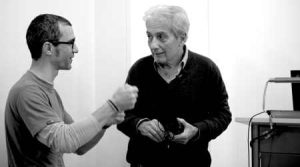From CIC nanoGUNE, Electrical Control of Magnetism by Electric Field and Current-induced Torques
Concludes by giving perspectives in terms of both emerging concepts in fundamental physics and new directions in materials science.
This is a Press Release edited by StorageNewsletter.com on April 24, 2024 at 3:01 pmIn a recent review article published in Reviews of Modern Physics, Fèlix Casanova, Nanodevices group, CIC nanoGUNE, professor Albert Fert, Nobel Prize in Physics, and his colleagues review the state of the art of electrical control of magnetism and give scientific and technological future persperctives.

Fèlix Casanova, Nanodevices group, CIC nanoGUNE and professor Albert Fert, Nobel Prize in Physics
Albert Fert, French physicist and winner of the Nobel Prize in Physics in 2007, is one of the discoverers of GMR, a physical effect that revolutionised HDD technology, allowing a huge increase in its capacity. His research enabled the capacity and applications of the HDD to be increased, and he is now working towards a new-gen of microprocessors that use much less energy. That is one of the challenges modern electronics is facing today. For that purpose, it is necessary to come up with new types of devices and CIC nanoGUNE and his Laboratory have been involved in a collaboration with Intel on such projects. He collaborates at experimental level with the nanodevices group at CIC nanoGUNE to advance and find new properties of quantum matter.
In this review, recent advances in the electrical control of magnetism (either by electric fields and by current-induced torques) are covered. Fundamental concepts in these 2 directions are reviewed first, their combination is then discussed, and finally a number of families of devices harnessing the electrical control of magnetic properties for various application fields are addressed. The review concludes by giving perspectives in terms of both emerging concepts in fundamental physics and new directions in materials science.
The story of the electrical switching of magnetization, which is discussed in this review, is that of a dance between fundamental research (in spintronics, condensed matter physics, and materials science) and technology (MRAMs, MESO transistors, microwave emitters, spin diodes, skyrmion-based devices, components for neuromorphics, etc.). This ‘pas de deux’ has led to major scientific and technological breakthroughs in recent decades (such as the conceptualization of pure spin currents, the observation of magnetic skyrmions, and the discovery of spin-charge interconversion effects).
Article: Electrical control of magnetism by electric field and current-induced torques
Reviews of Modern Physics has published an article written by Albert Fert, Laboratoire Albert Fert, CNRS, Thales, Université Paris–Saclay, 91767 Palaiseau, France, Department of Advanced Polymers and Materials: Physics, Chemistry and Technology, Faculty of Chemistry, University of Basque Country (UPV/EHU), 20018 Donostia–San Sebastian, Basque Country, Spain, and Donostia International Physics Center (DIPC), 20018 Donostia–San Sebastian, Basque Country, Spain, Ramamoorthy Ramesh, Department of Materials Science and Engineering, University of California, Berkeley, California 94720, USA, Department of Physics, University of California, Berkeley, California 94720, USA, Department of Physics and Astronomy, Rice University, Houston, TX 77005, USA, and Materials Sciences Division, Lawrence Berkeley National Laboratory, Berkeley, California 94720, USA, Vincent Garcia, Laboratoire Albert Fert, CNRS, Thales, Université Paris–Saclay, 91767 Palaiseau, France, Fèlix Casanova, CIC nanoGUNE BRTA, 20018 Donostia–San Sebastian, Basque Country, Spain and IKERBASQUE, Basque Foundation for Science, 48009 Bilbao, Basque Country, Spain, and Manuel Bibes, Laboratoire Albert Fert, CNRS, Thales, Université Paris–Saclay, 91767 Palaiseau, France.
Abstract: “The remanent magnetization of ferromagnets has long been studied and used to store binary information. While early magnetic memory designs relied on magnetization switching by locally generated magnetic fields, key insights in condensed matter physics later suggested the possibility of doing it by electrical means instead. In the 1990s, Slonczewski and Berger formulated the concept of current-induced spin torques in magnetic multilayers through which a spin-polarized current generated by a first ferromagnet may be used to switch the magnetization of a second one. This discovery drove the development of spin-transfer-torque magnetic random-access memories (MRAMs). More recent fundamental research revealed other types of current-induced torques named spin-orbit torques (SOTs) and will lead to a new generation of devices including SOT MRAMs and skyrmion-based devices. Parallel to these advances, multiferroics and their magnetoelectric coupling, first investigated experimentally in the 1960s, experienced a renaissance. Dozens of multiferroic compounds with new magnetoelectric coupling mechanisms were discovered and high-quality multiferroic films were synthesized (notably of BiFeO3), also leading to novel device concepts for information and communication technology such as the magnetoelectric spin-orbit (MESO) transistor. The story of the electrical switching of magnetization, which is discussed in this review, is that of a dance between fundamental research (in spintronics, condensed matter physics, and materials science) and technology (MRAMs, MESO transistors, microwave emitters, spin diodes, skyrmion-based devices, components for neuromorphics, etc.). This pas de deux has led to major scientific and technological breakthroughs in recent decades (such as the conceptualization of pure spin currents, the observation of magnetic skyrmions, and the discovery of spin-charge interconversion effects). As a result, this field has not only propelled MRAMs into consumer electronics products but also fueled discoveries in adjacent research areas such as ferroelectrics or magnonics. In this review, recent advances in the control of magnetism by electric fields and by current-induced torques are covered. Fundamental concepts in these two directions are reviewed first, their combination is then discussed, and finally current various families of devices harnessing the electrical control of magnetic properties for various application fields are addressed. The review concludes by giving perspectives in terms of both emerging fundamental physics concepts and new directions in materials science.“















 Subscribe to our free daily newsletter
Subscribe to our free daily newsletter

